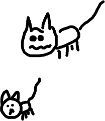Cat and Mouse

Jon the cat is chasing Terry the mouse through the house when Terry hides beneath a long rug, so that Jon cannot see where he is hiding.
Jon the cat decides to use Bayesian state estimation to determine the mouse's location. He starts by assuming that the mouse is equally likely to be in any of 9 discrete locations under the rug. Let L_t be a random variable representing the mouse's location at time t:
Jon has also, after years of mouse-chasing, built up a model for how mice move when they are trapped under rugs. According to his model, if a mouse is at location x at time n, then at time n+1, it will be at location x+1 with probability 0.5, and location x-1 with probability 0.5. If an action would take the mouse outside of the possible locations, that probability mass should be associated with the mouse staying in the same location:
Finally, although Jon cannot see where Terry is under the rug, cats generally have very acute senses of hearing, and so he decides to use his ears to locate the mouse. However, Jon is getting old, and so his hearing has deteriorated somewhat. He cannot discern the direction from which a sound is coming (only distance), and even that, he cannot pinpoint perfectly.
So Jon's observations will be in the form of hearing something n spaces away from his current location. If D_t is a random variable representing the mouse's actual distance away at time t, and O_t is a random variable representing the observed distance at time t, then Jon builds up the following model of his hearing:
Jon starts out by positioning himself at location 4 at time 0:

After all of the above has happened, Jon moves himself to location 3:
